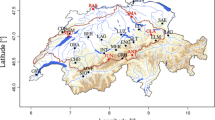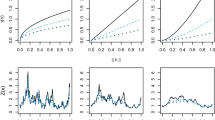Abstract
Bayesian multiple change-point models are built with data from normal, exponential, binomial and Poisson distributions with a truncated Poisson prior for the number of change-points and conjugate prior for the distributional parameters. We applied Annealing Stochastic Approximation Monte Carlo (ASAMC) for posterior probability calculations for the possible set of change-points. The proposed methods are studied in simulation and applied to temperature and the number of respiratory deaths in Seoul, South Korea.
Similar content being viewed by others
References
Barry D, Hartigan JA (1993) A Bayesian analysis for change-point problems. J Am Stat Assoc 88: 309–319
Belisle P, Joseph L, MacGibbon B, Wolfson DB, Berger R (1998) Change-point analysis of neuron spike train data. Biometrics 54: 113–123
Braga ALF, Zanobetti A, Schwartz I J (2002) The Effect of weather on respiratory and cardiovascular deaths in 12 U.S. Cities. Environ Health Perspect 110(9): 859–863
Carlin BP, Gelfand AE, Smith AFM (1992) Hierarchical Bayesian analysis of change point problems. Appl Stat 41: 389–405
Celeux G, Forbes F, Robert CP, Titterington DM (2006) Rejoinder. Bayesian Stat 1: 701–796
Chernoff H, Zacks S (1964) Estimating the current mean of a normal distribution which is subject to changes in time. Ann Math Stat 35: 999–1018
Chib S (1998) Estimation and comparison of multiple change-point models. J Econom 86: 221–241
Fearnhead P (2006) Exact and efficient Bayesian inference for multiple changepoint problems. Stat Comp 16: 203–213
Filleul L, Vandentorren S, Baldi I, Tessier JF (2001) Daily respiratory mortality and PM10 pollution in Mexico City. Euro Respir J 17: 1055–1056
Gauvin S, Zmirou D, Pin I, Quentin J, Balducci F, Boudet C, Poizeau D, Brambilla C (1999) Short-term effect of exposure to suspended particulate matter (PM10) on the respiratory function of urban asthmatic and control adults. J Environ Med 1: 71–79
Gelfand A, Smith A (1990) Sampling-based approaches to calculating marginal densities. J Am Stat Assoc 85: 398–409
Gelman A, Roberts GO, Gilks WR (1996) Efficient Metropolis jumping rules. Bayesian Stat 5: 599–607
Gelman A, Carlin J, Stern H, Rubin D (2003) Bayesian data analysis. Chapman and Hall, New York
Green PJ (1995) Reversible jump Markov chain Monte Carlo computation and Bayesian model determination. Biometrika 82: 711–732
Hawkins DM (2001) Finding multiple change-point models to data. Comp Stat Data Anal 37: 323–341
Hinkley DV (1970) Inference about the change-point in a sequence of random variables. Biometrika 57: 1–17
Kander Z, Zacks S (1966) Test procedure for possible changes in parameter of statistical distributions occurring at unknown time points. Ann Math Stat 37: 1196–1210
Kass RE, Raftery A (1995) Bayes factors. J Am Stat Assoc 90: 773–795
Koop GM, Potter SM (2004) Forecasting and estimating multiple change-point models with an unknown number of change-points, Federal Reserve Bank of New York Staff Reports, no. 196
Liang F (2007) Annealing stochastic approximation Monte Carlo for neural network training. Mach Learn 68(3): 201–233
Liang F, Wong WH (2000) Evolutionary Monte Carlo applications to C p model sampling and change-point problems. Stat Sinica 10: 317–342
Liang F, Liu C, Carroll R (2007) Stochastic approximation in Monte Carlo computation. J Am Stat Assoc 102: 305–320
Lupo AR, Kelsey EP, McCoy EA, Halcomb C, Aldrich E, Allen SN, Akyuz A, Skellenger S, Beiger DG, Wise E, Schmidt D, Edwards M (2003) The presentation of temperature information in television broadcasts: what is normal?. Natl Weather Dig 27(4): 53–58
Maguire BA, Pearson ES, Wynn AHA (1952) The time intervals between industrial accidents. Biometrika 38: 168–180
Nevel’son MB, Has’minskii RZ (1973) Stochastic approximation and recursive estimation. American Mathematical Society, Providence RI
Raftery AE, Akman VE (1986) Bayesian analysis of a Poisson process with a change-point. Biometrika 73: 85–89
Robbins H, Monro S (1951) A stochastic approximation method. Ann Math Stat 22: 400–407
Schwartz J (1994) Nonparametric smoothing in the analysis of air pollution and respiratory illness. Can J Stat 22(4): 471–487
Smith AFM (1975) A Bayesian approach to inference about a change-point in a sequence of random variables. Biometrika 62: 407–416
Stephens DA (1994) Bayesian retrospective multiple-change-point identification. Appl Stat 43: 159–178
Tierney L (1994) Markov chains for exploring posterior distributions (with discussion). Ann Stat 22: 1701–1762
Venter JH, Steel SJ (1996) Finding multiple abrupt change-points. Comp Stat Data Anal 22: 481–504
Wang F, Landau DP (2001) Efficient, multiple-range random walk algorithm to calculate the density of states. Phys Rev Lett 86: 2050–2053
Yao YC (1984) Estimation of a noisy discrete-time step function: Bayes and empirical Bayes approaches. Ann Stat 12: 1434–1447
Author information
Authors and Affiliations
Corresponding author
Additional information
This work was supported by the Korea Science and Engineering Foundation (KOSEF) grant funded by the Korea government (No. R01-2008-000-10133-0).
Rights and permissions
About this article
Cite this article
Kim, J., Cheon, S. Bayesian multiple change-point estimation with annealing stochastic approximation Monte Carlo. Comput Stat 25, 215–239 (2010). https://doi.org/10.1007/s00180-009-0172-x
Received:
Accepted:
Published:
Issue Date:
DOI: https://doi.org/10.1007/s00180-009-0172-x




